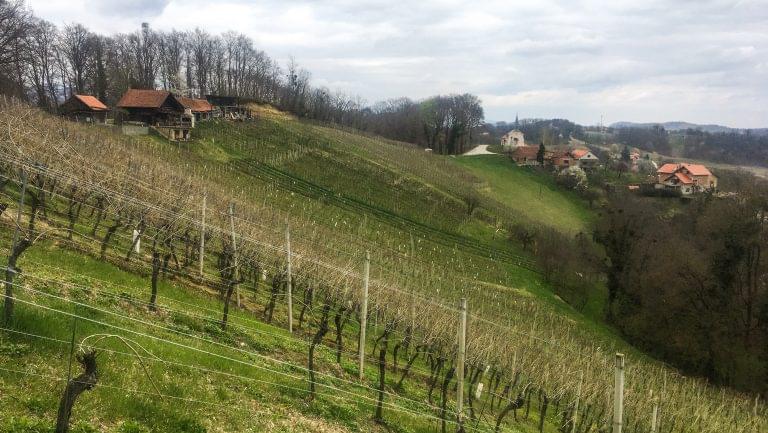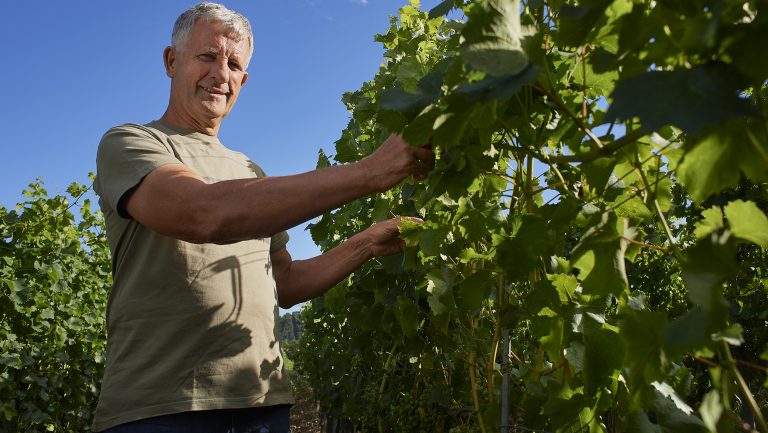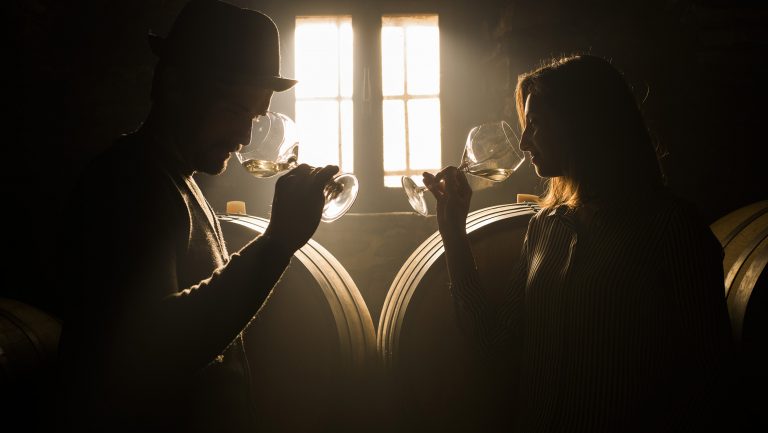Slovenian wine is on the rise. For a tiny nation of just over 7,800 square miles, the wines that break out of this nearly landlocked country deliver a big impact. Most bottles alighting on U.S. shores follow a similar ethos: minimal intervention, small production, showcasing indigenous and international varieties, and accessible in taste and price point.
Located at the crossroads of mountains and sea, Slovenia features diverse landscapes spanning the Julian Alps, lakes, forests, and coastal areas along the Adriatic Sea. Geographically, Slovenia forms part of Central Europe with borders on Italy to the west, Austria to the north, Hungary to the east, and Croatia to the south, all major wine-producing countries.
The cultivation of grapevines within the borders of present-day Slovenia traces back to the Celts and Illyrians, who inhabited the region around 400 BC. The Romans arrived in the 1st century BC, expanding viticulture to slake the thirst of the Empire’s growing colonies. Winemaking continued through the Middle Ages, flourishing through the diligence of Monastic orders. In the 14th century, the Slovenian territories came under the rule of the Habsburg dynasty. A relic of the era, the world’s oldest vine currently ages in Maribor—with a dedicated museum—at 450 years old.

Don’t miss the latest drinks industry news and insights. Sign up for our award-winning newsletters and get insider intel, resources, and trends delivered to your inbox every week.
Eventually, phylloxera, then socialist control in the 20th century—during which the state took control of the wine industry—would stall artisan and fine wine production.
“Slovenia has had its ups and downs,” explains Peter Gonc, the winemaker for Gonc Winery in Ptuj, the oldest city in Slovenia, located in the Podravje wine region. “Before 1991, we lived in Yugoslavia, a Communist-oriented state. Basically, you could not own a winery. Everything was government-run. Huge wineries turned out mass-produced bottles for supermarket chains; there was not much free thinking allowed.”
Then in 1991, Slovenia won its independence, sparking the modern-day wine industry. “After that, winemakers at big companies went independent and started personal brands,” says Gonc. “Slovenia is in an awakening stage right now. The generations are changing from old to new, and there is a different approach to winemaking, in a positive way.”
Gonc, whose wines are imported by JP Bourgeois, works in a minimal-intervention style, often with skin contact, and features modern, rock and roll-inspired labels on his bottles. Gonc’s wines have figured prominently in the wine trade’s embrace of the growing Slovenian natural, minimalist wine movement.
Today, the Slovenian Ministry of Agriculture, Forestry and Food estimates the country has around 17,500 hectares of vineyards, over 2,500 wineries, and a production volume of between eight and nine million liters a year from 50 to 60 varieties.
“Slovenia is exciting for a few reasons,” says Daniel Lukin-Beck, the general manager of Vinum Importers. “The wines are lively and refreshing, dripping with youthful energy and discovery. For Slovenian wines to increasingly be able to claim their seat at the table alongside some of the best wines in the world, there is only excitement ahead. The story is still being written as we speak.”

Key Wine Regions
Slovenia has nine winegrowing districts that fall within three main regions: Podravje in the northeast, Primorska in the west, and Posavje just south of the center.
Podravje
Named for the Drava River and accounting for approximately half of the country’s total wine production, Podravje is divided into two districts: Štajerska and Prekmurje. Of the duo, Štajerska forms the core of the country’s wine industry. Terraced, sloped vineyards outside the town of Maribor, carpet the valleys of the Pesnica, Drava, and Mura rivers. Growers working in soils of sand and clay with marl found in the lower layers shepherd aromatic white varieties like Riesling, Pinot Grigio, and Traminer into crisp, bright wines. The region’s Sauvignon Blanc competes with the best in the world, as do its dessert wines.
Primorska
This coastal region stretched along the Adriatic has a warmer Mediterranean climate comparable to nearby Friuli-Venezia Giulia. Soils comprised of marine sediment, known as flysch, can be found throughout the region as clay, marl, limestone, and sandstone layers. The district of Goriška Brda, facing the Gulf of Trieste, has drawn attention to the region for its success with Rebula, Chardonnay, Merlot, and Cabernet Sauvignon.

What You Need to Know About Croatian Wine
Masters of Wine aren’t the only ones clamoring for more of the country’s wines—here’s what to try
Posavje
Posavje, named after the Sava River, is Slovenia’s smallest region. Local producers, many amateurs with petite plots, focus on sparkling, Chardonnay, Pinot Noir, rosé, and sweet wines. Cvicek, a specialty of Psoavje, is a sour, lower-alcohol wine produced from a blend of red and white varieties.
Key Grape Varieties
According to Lukin-Beck, there are many different indigenous varieties with different names worth investigating, but in his mind, it’s the international grapes that have “found an authentic home in these regions,” that he finds exciting.
“Of course, that begs the question of what makes a grape international? This region sits at the east-west crossroads of Europe, where many empires have found a strategic holding in the Balkans,” says Lukin-Beck. Consequently, many varieties have migrated over the border throughout time.
Regarding the small-production, natural wine movement, Lukin-Beck says that the trend connects to the fact that many producers count as first-generation. “Natural wine and Slovenian wines sales tend to run a parallel course because these wine drinkers are also adventurous enough to try and appreciate wines from this part of the world. Many producers have taken heed of these natural styles, following their peers,” he says.

Rebula (Ribolla Gialla)
Rebula, especially from the marl soils of Brda in Primorska, helped put Slovenia on the American wine map. Known for its crisp acidity, minerality, and floral and ripe citrus notes, Rebula often sees skin contact for additional texture, flavor, and a richer, fuller body.
Sauvignon Blanc
Slovenian Sauvignon Blanc ranks among the great regions of the world. Stylistically, the wines exhibit textbook vibrant acidity, herbal aromas, and tropical fruit notes. “Sauvignon Blanc from Steiermark is double [the price of] what one would be from Štajerska, right over the border,” says Lukin-Beck, pointing out the quality-to-value ratio in Slovenian wine.
Modri Pinot (Pinot Noir)
Pinot Noir was brought to Štajerska by Carthusian monks in the 12th century. “They saw it as an exceptional place for growing this variety due to the area’s cool climate, windy valleys, steep slopes, and limestone soils,” says Lukin-Beck. Given the increasing difficulty of finding good, affordable Pinot Noirs, this region provides a good alternative as it “produces elegant, Burgundian styles,” he says.
Refosco
Red grape Refosco excels in the Slovenska Istra (Slovenian Istria) wine-growing district of Primorska. It produces wines with deep color, medium to full body, high acidity, and flavors of dark berries, spices, and earthy undertones.
Modra Frankinja (Blaufränkisch)
Like Pinot Noir, Blaufränkisch also thrives in Štajerska. “Compared to Austria, the wines show more fruit, though with trademark bright, crunchy notes and a mineral backbone,” says Lukin-Beck. “These reds have tremendous potential.”

Dispatch
Sign up for our award-winning newsletter
Don’t miss the latest drinks industry news and insights—delivered to your inbox every week.
Lauren Mowery‘s work can be found at laurenmowery.contently.com. When not studying for the Masters of Wine exam, she enjoys not studying for the Masters of Wine exam.






